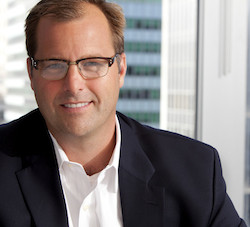For all the hoopla about cloud computing, it’s easy to forget that the idea of companies placing their critical IT systems and storage into data centers they didn’t own would have been dismissed as far-fetched as recently as five years ago.
Yet that’s precisely what’s happened in capital markets, in which data centers, as a byproduct of the rise of electronic trading, have eclipsed trading floors in matching buy and sell orders.
Telx, for example, operates 19 data centers across the U.S., including locations in New York and northern New Jersey, Chicago, San Francisco, Dallas and Los Angeles.
“Fragmentation is very much a reality,” said Shawn Kaplan, general manager of financial services at Telx. “In U.S. equity markets alone, there are more than 10 equity exchanges and 40 dark pools, so connectivity is critical.”
In January, Telx completed its purchase of 100 Delawanna Avenue, the location of its Clifton, New Jersey NJR2 datacenter, from Mountain Development Corporation. The purchase allows Telx to develop an advanced data-center campus and technology center to develop new products and services.
 “Access to liquidity, security and reliability are top concerns, but in today’s markets, cost of ownership is also becoming an increasing concern.”
Shawn Kaplan, general manager of financial services at Telx
“Access to liquidity, security and reliability are top concerns, but in today’s markets, cost of ownership is also becoming an increasing concern.”
Shawn Kaplan, general manager of financial services at Telx
“A big reason why the financial-services marketplace has realized the benefit of our carrier connection facilities is that our data centers are connecting to these 50 venues, which generates tremendous benefits for the industry in a fragmented environment,” Kaplan told Markets Media.
“The cost of locating in every exchange center is exorbitant,” Kaplan continued. “Some very high-tech automated firms are trying to arbitrage the buy side’s shortcoming in technology by doing that. But costs continue to escalate and profits are down so only a few of the largest firms can afford to continue to host there.”
Telx Chief Executive Eric Shepcaro joined Telx in 2007, shortly after the company was purchased by private-equity concern GI Partners.
“The vision of the private-equity guys was to scale and build the company, and transform it in many different ways,” Shepcaro said. “At the time, the company was 100% focused on network and service providers, mostly global telecom companies. That started to change in 2008.”
Infrastructure Host
Shepcaro, who had previously run the managed services business at AT&T, presided over Telx’s transformation into a provider of hosted infrastructure services for financial services and other industry verticals such as healthcare and entertainment.
Financial markets have evolved from floor-based to mostly electronic trading over the past decade-plus, and market participants stand to benefit from the infusion of advanced data-center technology deployed by infrastructure providers such as Telx. In many cases, trading is not about who you know or what you know, it’s about where you are.
“No longer do we have aggressive traders on the floors of the exchanges,” Kaplan said. “We now have highly educated technologists trading based on the nanoseconds lost or gained by the proximity of their trading engine to the matching engines, the routes taken by their fiber, or the location of their systems inside the datacenter.”
The Clifton campus of Telx is being outfitted for ultra low latency as well as airtight security to meet the needs of present and future market participants. The location, eight miles west of New York City, consists of two independent facilities, NJR2 and NJR3.
The NJR3 facility contains 215,000 gross square feet of high-power density, energy efficient space and more than 100,000 square feet of customizable colocation space. Together with the adjacent NJR2, the campus allows clients to establish physical redundancy in two completely separate infrastructures managed by the same data-center operator, according to Telx.
For market participants, “access to liquidity, security and reliability are top concerns, but in today’s markets, cost of ownership is also becoming an increasing concern,” Kaplan said. “The Telx Clifton campus was designed with the most advanced set of features, but also to operate at a price point which can make an impact on the bottom line.”
"Telx is 20% to 30% closer to the NYSE matching engines than competing facilities in Secaucus and Weehawken,” said Telx's Kaplan.
Security at Telx’s Clifton campus includes a fully fenced-in perimeter and motion-detecting cameras tracking all movements inside the campus, Kaplan said. Also, “‘man traps’, access zones, security escorts and biometric systems will ensure only authenticated individuals are permitted access and only within the areas they are designated.”
With latency critical in today’s automated trading environments, the Telx Clifton campus sits in a prime location, about equidistant between NYSE Euronext and Nasdaq OMX data centers.
“With the newly optimized fiber routes in New Jersey, Telx is 20% to 30% closer to the NYSE matching engines than competing facilities in Secaucus and Weehawken,” Kaplan said. “The Telx Clifton campus runs right along the new fiber paths, and for those choosing microwave, ample roof rights are available.”
“Connectivity to market data is critical to our business, and all of the major data providers have connectivity in Telx,” said Michael Crispino, director of infrastructure services at Capstone, a $2 billion hedge fund that specializes in options trading.
The resilience of the data center proved to be beneficial in the wake of superstorm Sandy, when 15 feet of water pooled in the basement of Capstone’s 7 World Trade Center location. “The building was down for four days, but our operations were uninterrupted” because the hedge fund was able to work through Telx Clifton.
Capstone, which has worked with Telx for six years, is “not a latency-sensitive shop today, but the paradigm is changing,” Crispino said.
That paradigm has been changing since at least 1971, when Nasdaq became the first electronic exchange and the pendulum between human traders and machines began to swing. “Today, no longer are trades handled by people on noisy exchange floors,” said Kaplan. “The new trading floors have migrated to chilled data-center facilities, without a trader in sight.”
Fastest Wins
Most of the world’s electronic matching engines operate price-time priority in a central limit order book, which means that the first order to arrive at the best price will be executed. “Compared to auction-style trading methods, price-time priority places a tremendous emphasis on getting your trade in quickly,” said Kaplan. “Just a microsecond or less can determine whether your trade will get filled or whether you’ll pay more.”
Tracking the fragmentation of the landscape for equity-trading venues, markets for some other asset classes are also dispersing. “The futures markets, while not quite as fragmented as the equities space, adds a half-dozen venues and the new Swaps Execution Facilities could add several dozen.”
In 2011, Telx was purchased by Boston-based investment firms, ABRY Partners and Berkshire Partners. Before the transaction, the company had signaled it would raise capital in an initial public offering. Privately owned Telx is based in New York and services 13 U.S. markets, from South Florida to the Pacific Northwest.
The systemic latency of the leading high-frequency trading applications can be as little as a handful of microseconds achieved through high-performance computing techniques such as hardware acceleration, kernel bypass, and massive parallelization.
In relative terms, the speed of light travels only about 200 meters per microsecond, a distance easily traversed inside most data centers, let alone between buildings or even states. Unique among industry verticals, financial services has seen benefits from ecosystems of business partners inside of datacenter colocation facilities.
“Colocation initially started in an effort to reduce the transaction latency for trade executions, but moving forward the operational efficiencies of cross-connecting between business partners is emerging to become equally important,” said Kaplan. “Within facilities such as the Telx Clifton campus, you can now readily access managed service providers, brokers, clearing firms, cloud compute platforms, and leading fiber network providers.”
The data centers of the future are beginning to emerge with distinct specialization.
“There are essentially three types of facilities,” Kaplan said. First, “the carrier-neutral ‘carrier hotels’ have emerged as critical locations for latency reduction such as in execution technologies.” Examples of this facility are 111 8th Avenue in New York and and 350 East Cermak in Chicago, he said.
The second is a ‘proximity’ datacenter which is where most enterprise colocation has migrated.
“These proximity centers are close enough to corporate offices to send technicians but are lower-priced than the carrier hotels which are often inside the city centers,” Kaplan said. “These campus-style facilities can be strategically located near public transportation, redundant power grids, and have sufficient power density and cooling to host high-density footprints.”
Lastly, there are the low-cost cloud computing centers for commodity processing. “These are often placed far outside of the populated cities where low-cost real-estate and power is plentiful,” said Kaplan. “In the future, it is likely you will see lower-cost facilities located in northern latitudes where ambient air cooling or chilled water can reduce the costs of cooling equipment.”














